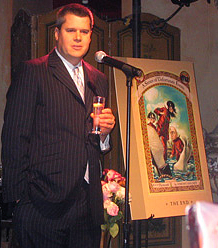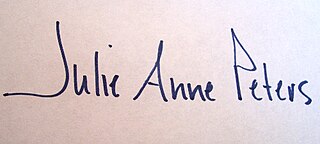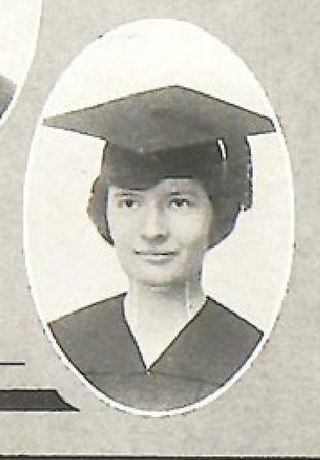
Lemony Snicket is the pen name of American author Daniel Handler. Handler has published several children's books under the name, most notably A Series of Unfortunate Events, which has sold over 60 million copies and spawned a 2004 film and TV series from 2017 to 2019. Lemony Snicket also serves as the in-universe author who investigates and re-tells the story of the Baudelaire orphans in A Series of Unfortunate Events.

Daniel Handler is an American author, musician, screenwriter, television writer, and television producer. He is best known for his children's book series A Series of Unfortunate Events and All the Wrong Questions, published under the pen name Lemony Snicket. The former was adapted into a film in 2004 as well as a Netflix series from 2017 to 2019.

A public library is a library, most often a lending library, that is accessible by the general public and is usually funded from public sources, such as taxes. It is operated by librarians and library paraprofessionals, who are also civil servants.

The John Newbery Medal, frequently shortened to the Newbery, is a literary award given by the Association for Library Service to Children (ALSC), a division of the American Library Association (ALA), to the author of "the most distinguished contributions to American literature for children". The Newbery and the Caldecott Medal are considered the two most prestigious awards for children's literature in the United States. Books selected are widely carried by bookstores and libraries, the authors are interviewed on television, and master's theses and doctoral dissertations are written on them. Named for John Newbery, an 18th-century English publisher of juvenile books, the winner of the Newbery is selected at the ALA's Midwinter Conference by a fifteen-person committee. The Newbery was proposed by Frederic G. Melcher in 1921, making it the first children's book award in the world. The physical bronze medal was designed by Rene Paul Chambellan and is given to the winning author at the next ALA annual conference. Since its founding there have been several changes to the composition of the selection committee, while the physical medal remains the same.

Alex Sanchez is a Mexican American author of award-winning novels for teens and adults. His first novel, Rainbow Boys (2001), was selected by the American Library Association (ALA), as a Best Book for Young Adults. Subsequent books have won additional awards, including the Lambda Literary Award. Although Sanchez's novels are widely accepted in thousands of school and public libraries in America, they have faced a handful of challenges and efforts to ban them. In Webster, New York, removal of Rainbow Boys from the 2006 summer reading list was met by a counter-protest from students, parents, librarians, and community members resulting in the book being placed on the 2007 summer reading list.
The American Library Association (ALA) is a nonprofit organization based in the United States that promotes libraries and library education internationally. It is the oldest and largest library association in the world, with 49,727 members as of 2021.

A Series of Unfortunate Events is a series of thirteen children's novels written by American author Daniel Handler under the pen name Lemony Snicket. The books follow the turbulent lives of orphaned siblings Violet, Klaus, and Sunny Baudelaire. After their parents' death in a fire, the children are placed in the custody of a murderous villain, Count Olaf, who attempts to steal their inheritance and causes numerous disasters with the help of his accomplices as the children attempt to flee. As the plot progresses, the Baudelaires gradually confront further mysteries surrounding their family and deep conspiracies involving a secret society.
A book discussion club is a group of people who meet to discuss a book or books that they have read and express their opinions, likes, dislikes, etc. It is more often called simply a book club, a term that is also used to describe a book sales club, which can cause confusion. Other frequently used terms to describe a book discussion club include reading group, book group, and book discussion group. Book discussion clubs may meet in private homes, libraries, bookstores, online forums, pubs, and in cafés or restaurants over meals or drinks.

Nancy Pearl is an American librarian, best-selling author, literary critic and the former Executive Director of the Washington Center for the Book at Seattle Public Library. Her prolific reading and her knowledge of books and literature first made her locally famous in Seattle, Washington, where she regularly appears on public radio recommending books. She achieved broader fame with Book Lust, her 2003 guide to good reading. Pearl was named 2011 Librarian of the Year by Library Journal. She is also the author of a novel and a memoir.
Literary fiction, mainstream fiction, non-genre fiction, serious fiction, high literature, artistic literature, and sometimes just literature are labels that, in the book trade, refer to market novels that do not fit neatly into an established genre ; or, otherwise, refer to novels that are character-driven rather than plot-driven, examine the human condition, use language in an experimental or poetic fashion, or are simply considered serious art.

Julie Anne Peters was an American author of young adult fiction. Peters published 20 works, mostly novels, geared toward children and adolescents, many of which feature LGBT characters. In addition to the United States, Peters's books have been published in numerous countries, including South Korea, China, Croatia, Germany, France, Italy, Indonesia, Turkey and Brazil. Her 2004 book Luna was the first young-adult novel with a transgender character to be released by a mainstream publisher.

Booklist is a publication of the American Library Association that provides critical reviews of books and audiovisual materials for all ages. Booklist's primary audience consists of libraries, educators, and booksellers. The magazine is available to subscribers in print and online. It is published 22 times per year, and reviews over 7,500 titles annually. The Booklist brand also offers a blog, various newsletters, and monthly webinars. The Booklist offices are located in the American Library Association headquarters in Chicago’s Gold Coast neighborhood.
Inspirational fiction is a sub-category within the broader categories of "inspirational literature" or "inspirational writing." It has become more common for booksellers and libraries to consider inspirational fiction to be a separate genre, classifying and shelving books accordingly. Reasons for this include the increased popularity of inspirational fiction in recent years, and the appeal of inspirational fiction beyond readers of the genre that these books would otherwise be classified in.
A book talk is what is spoken with the intent to convince someone to read a book. Booktalks are traditionally conducted in a classroom setting for students; however, booktalks can be performed outside a school setting and with a variety of age groups as well. It is not a book review, a book report, or a book analysis. The booktalker gives the audience a glimpse of the setting, the characters, and/or the major conflict without providing the resolution or denouement. Booktalks attempt to make listeners care enough about the content of the book to want to read it. A long booktalk is usually about five to seven minutes long and a short booktalk is generally 180 seconds to 4 minutes long.
Genreflecting is the process of examining and analyzing the patterns and characteristics of literary genres—both fiction and recreational nonfiction—and using that analysis to identify titles with similar appeals to readers, in order to make reading suggestions to individuals who are looking for something to read.

Charlemae Hill Rollins was a pioneering librarian, writer and storyteller in the area of African-American literature. During her thirty-one years as head librarian of the children's department at the Chicago Public Library as well as after her retirement, she instituted substantial reforms in children's literature.

Margaret Alexander Edwards was an American educator and librarian who was at the forefront of the movement for young adult services in the 20th century. She is the namesake of the Margaret Edwards Award for young adult literature.

All the Wrong Questions is a four-part children's book series and prequel to A Series of Unfortunate Events by Lemony Snicket. The series explores Snicket's childhood apprenticeship to the secret society V.F.D and expands the fictional universe introduced in the novel The Bad Beginning, the first of thirteen installments in the A Series of Unfortunate Events books.
Carla Killough McClafferty, is an American author of non-fiction for children, writing mostly about science and history. The International Reading Association awarded the 2007 Children's Book Award for Intermediate Nonfiction to her book Something Out of Nothing: Marie Curie and Radium. The National Council of Teachers of English gave a 2008 Orbis Pictus Recommended book designation to In Defiance of Hitler: The Secret Mission of Varian Fry.

Who Could That Be at This Hour? is the first novel of the children's novel series All the Wrong Questions by Lemony Snicket, a series set before the events of A Series of Unfortunate Events. The novel tells the story of a young Lemony Snicket, who is apprenticing for the V.F.D. under the worst-ranked agent, S. Theodora Markson. The book was published on October 23, 2012, by Little, Brown and Company and illustrated by Seth.
.













